Listen to Lots to Grow on any podcast app








Anchor.fm - Apple Podcasts - Spotify - Google Podcasts - Breaker - Pocket Casts - RadioPublic - Stitcher - Overcast
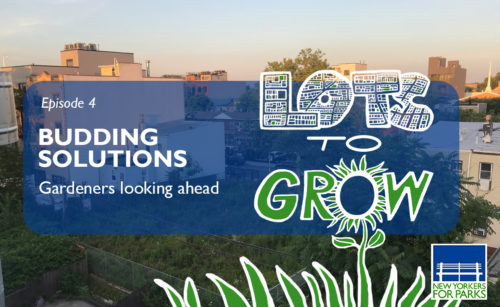
Community gardens in New York City have existed since the 1970s fiscal crisis. Their cultural significance and services make them valuable to neighborhoods, but the initial agreements that allowed them to flourish have always kept them as temporary public spaces that can be replaced by other uses. Over time, advocates and elected officials have grappled with potential policies to establish a comprehensive solution to gardens’ vulnerability, but to date, no winning strategy has emerged. On this episode of Lots to Grow, we explore the different policies that have been suggested, hear what gardeners envision for the future, and discuss what anyone can do to get involved.
We hear from the following individuals representing the following organizations and gardens:
- Aziz Dehkan, from the New York City Community Garden Coalition
- Irene Van Slyke, from the Brooklyn-Queens Land Trust and the David Foulke Memorial Garden
- Genevieve Outlaw, from the Manhattan Land Trust and the Hope Steven Garden
- Celeste Leon, from Brooklyn Community Board 4 and the Know Waste Lands Garden
- Mychal Johnson, from South Bronx Unite and the Mott Haven-Port Morris Community Land Stewards
- Charles Krezell, from the Loisaida United Neighborhood Gardens (LUNGS) and the Fireman's Garden
- Gloria Tellez-Tovar, from the Brooklyn Community Education Council of District 32
- Amantina Duran, from La Casita Verde Community Garden
- Kofi Thomas, from the Good Life Garden
Music on this episode is by Audiobinger, Speck, Stefan Kartenberg, Martijn de Boer (NiGiD), onlymeith, norelpref, yurex, ritmosrudos, PowerpuffTune, airtone, Bluemillenium, Tato Torres, and gurdonark.
Audio from a rally at City Hall on September 19, 2019 is from the New York City Community Garden Coalition.
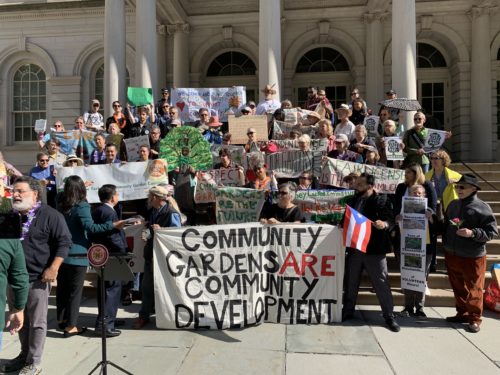
Start of recording - “The Garden State” by Audiobinger fades in
For New Yorkers for Parks, this is Lots to Grow, the podcast about gardens and communities in New York City. I’m Jessica Saab. Welcome back! At long last, this is the final episode in our four-part series about New York City’s community gardens, unique open spaces made and maintained by volunteers. We last left off at a pivotal point, where some of New York City’s over 20,000 gardeners were clashing with NYC Parks Department officials over the legal documents that allow them to have gardens on publicly owned land. Since then, things have continued to escalate and are still currently at a standoff.
Aziz Dehkan: GreenThumb has threatened to lock people who have not signed this license out of their garden, to not allow access. So what do we say to them?
Crowd: Don’t lock us out! Don’t lock us out! Don’t lock us out! Don’t lock us out!
Those were the voices of gardeners and supporters at a City Hall rally on September 19th. Leading the chant was Aziz Dehkan, who we heard from on our previous episodes and who is the Executive Director of the New York City Community Garden Coalition, one of the main citywide garden network organizations. Across the country, community gardens in other cities are suffering, too, caught in similar issues of impermanence and insecurity. However, New York City is unique – it has the most community gardens – over 550 – that are feeling the most pressure for development from both public and private entities. Over the course of this podcast, we’ve learned that communities value these spaces; people find them beautiful, healing, and helpful. But they are run by volunteers, which means that regulating them is difficult, and running them is a series of challenge after challenge. And at the end of the day, the grand majority of New York City’s community gardens are impermanent, at the risk of being built over for something else. So let’s jump into it. How can community gardens be preserved, if at all? On this last episode of Lots to Grow, we’re going to review the options that exist to try to determine what may be the potential path forward.
“The Garden State” by Audiobinger fades in a bit louder
So let’s begin with an obvious question: why aren’t community gardens permanent open spaces? As we’ve learned, most gardens grow on land owned by different city agencies, a remnant from days of hard financial times and widespread property abandonment. Volunteers who establish gardens are given permission to do so from the presiding public agency. This permission can be revoked within 60-days’ notice if the agency needs the land for something else. For this reason, most gardens exist with a threat of potential displacement. Some gardens are different, though—a fraction of New York City’s community gardens grow on privately owned land. The private landowners can be individuals or organizations, but some are land trusts, which are nonprofit organizations that own land to preserve it as it is. Gardens owned by land trusts enjoy a greater sense of security—as privately owned spaces, nothing can take over their land and make them disappear—at least in theory. This solution to garden impermanence works well for those gardens owned by land trusts, but private ownership cannot be the solution for all community gardens, at least not with the way the garden land trusts work today.
"Lucky Massive Dangerous" by Speck fades in
Let’s explore why not. Land trusts own land to conserve its natural qualities. According to the Land Trust Alliance, a national nonprofit that provides resources to these conservation organizations, there are over a thousand land trusts in the United States. In New York City, there are three land trusts, established specifically to preserve about 70 community gardens through private ownership. This is how they mainly work: the land trusts own the land and are run by boards of representatives, which are mostly made up of volunteer gardeners that garden on the land owned by the land trusts. This gives those volunteers a sense of ownership because, while they’re not the technical landowners as individuals, they do help run the organization that owns the land outright. While the three land trusts—the Manhattan Land Trust, the Bronx Land Trust, and the Brooklyn-Queens Land Trust—differ slightly in how they function, they strive to come to collective decisions and provide each garden with equal representation. So how did these land trusts come to be?
"Summer breeze folk" by Stefan Kartenberg fades in
We went over this in the first episode of Lots to Grow – in 1999, when 114 garden sites were almost sold at public auction, two large nonprofit organizations—the Trust for Public Land and the New York Restoration Project—stepped in to purchase them, and when they did, they split them up between each other. The Trust for Public Land is a national nonprofit that helps establish other land trusts by purchasing natural areas for preservation. The New York Restoration Project is a New York-specific nonprofit that supports and beautifies the city’s open spaces in different ways. The Trust for Public Land established the three garden land trusts that are still going strong today by gifting them the land they purchased in the auction, whereas the New York Restoration Project held onto the 50 gardens they got in the deal to refurbish and maintain them long term. Establishing the three smaller land trusts was not a smooth process—logistically, the small organizations faced many hurdles, and the challenges they continue to face today are why they cannot be a solution for all of the City’s gardens. Here’s Irene Van Slyke, who you may remember from our first episode, describing how the process has been for the land trust her garden is a part of.
Irene Van Slyke: I think over time—of course, it’s not the same organization—but I think we have stayed true to... the garden groups are in charge of their garden. And it’s incorporated in our new bylaws that that’s how it works, that each garden has a vote, so that when we meet, when we vote, the garden votes, not the people necessarily. It’s sort of like the U.S. Senate I guess. The garden has a voice always.
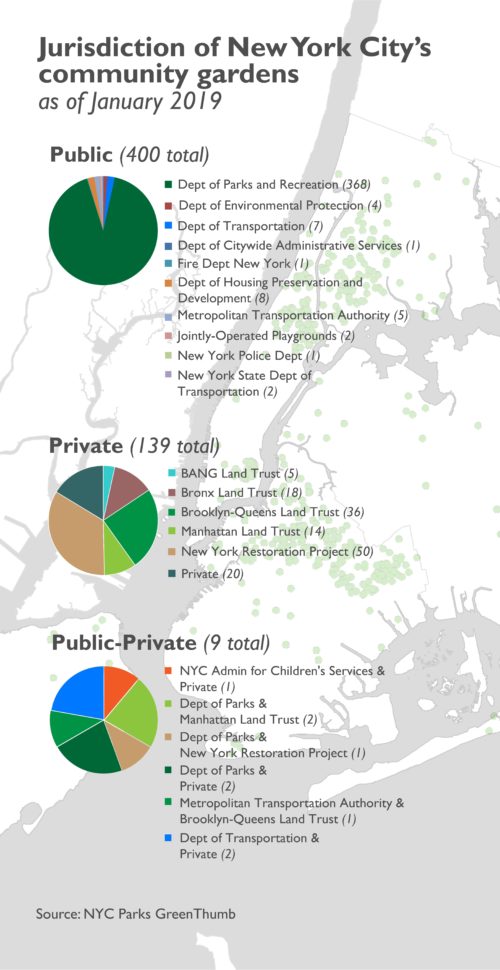
Irene’s been a community gardener since 1971 at the David Foulke Memorial Garden, which has been part of the Brooklyn-Queens Land Trust since its formal establishment in 2004. The Brooklyn-Queens Land Trust, or BQLT for short, owns 36 garden sites across—you guessed it—both Brooklyn and Queens. Irene has served on the board as the Treasurer for multiple terms, and while she enjoys it, she admits it’s a lot of work. It’s an extra volunteer effort apart from the time she already volunteers at the garden she’s a part of. The work involves fundraising to pay public agency fees for things like sidewalk repairs, rodent mitigation, and the use of water from the City’s fire hydrants, to name a few. These are fees that community gardens on publicly owned land do not have to pay, which puts an expensive strain on these organizations. Here’s Genevieve Outlaw, who you may also remember from our previous episodes, and who serves as the Board President of the Manhattan Land Trust, which owns 14 garden sites across the island of Manhattan.
Genevieve Outlaw: Money, we work hard to raise money. So yeah. And you know, most money that you get from politicians, they don’t give money for administration, for administrative costs, like rent and telephone and stuff like that; they’ll give money for programs. So we have to raise the money to make sure that we have money in case something happens with one of the gardens and they can’t handle it, and maybe it’s something they’re not supposed to handle. Because we’re supposed to take care of the sidewalks, we pay insurance—you know, that kind of thing. So that’s not on the gardens to do.
One thing that does lessen the load is their tax-exempt status: New York City’s community garden land trusts do not have to pay taxes on their properties or operations. However, if they fall behind paying public fees, they could lose their properties due to tax liens, which are accumulated debts that can be sold to a third-party. It’s unusual, but it’s a possibility, so board volunteers need to stay vigilant and organized in their record-keeping, lest a property slip through the cracks and enter the free market again. Running a land trust requires a dedicated board and strong leadership but, without the ability to pay staff, finding those dedicated individuals who are gardeners and who are passionate about maintaining the garden properties is tough.
Irene Van Slyke: It’s a challenge to get board members and we have a six-year timeframe they can serve and then they go off the board, because we have term limits, so you really asking people for a long-term commitment, and people are not always willing to do that. Gardeners want to garden and they don’t necessarily want to be on the board. You know, we ask a lot from board members. They organize the events. They help with the financial management. They write the grants, you know—other organizations would have a grant writer, we don’t have one—it’s all done by the board. So... it’s tough, you know, you have to find people with those skills who are gardeners and who are willing to serve... it’s like a triple challenge.
"Spring Bossa" by Martijn de Boer (NiGiD) fades in
The costs from fees and from providing resources stack up and cause significant strain on the land trust boards. As the private owners of open spaces, they straddle being private but acting public in ways that can cause confusion. Since their gardens do not have to be registered with any city agency or with GreenThumb, the community gardening program of the New York City Parks Department, they don’t actually need to follow the same rules other publicly owned gardens do, like being open for 20 hours a week during the more temperate months, which means land trust gardens can be less open and less accessible.
Irene Van Slyke: We talked about what that would mean eventually. What is it—it’s private? Is it really open to the public? And you know sometimes we’re struggling with it because we are not for profit tax-exempt organization so we tell people, if you are a garden group, you do have to be open to the public. And you do have to go out and find more members. You cannot just keep it for 2, 3, or 4 people. And it’s you know, people like their little private... So we—that is our role as a board, to instill that in people. You know that, it’s not your private property really. Being tax-exempt means you’re public basically.
If land trusts were exempt from public fees as well, they could continue to provide public benefits to all New Yorkers without shouldering so much fundraising responsibility in a volunteer capacity. Since land trusts exist for the conservation of nature, some see New York City’s garden land trusts as the ideal solution for the ongoing issues around community garden preservation, and have suggested that gardens on publicly owned land should either be sold or donated to the land trusts for them to keep within their portfolios of preservation.
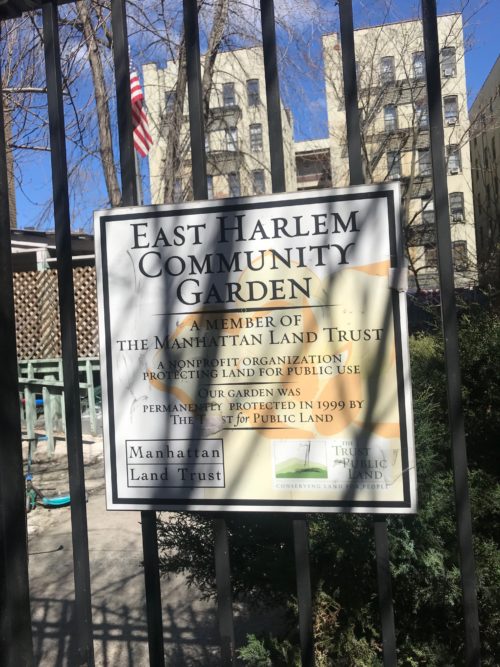
However, because of the costs from fees and organizational challenges, New York City’s community garden land trusts as they exist now do not have the capacity to take on additional—much less, all—of the City’s gardens. But when neighborhoods are changing, new developments are popping up all over, and community members feel that gardens on either publicly or privately owned land are at risk of being overtaken by other uses, some see the land trust model as the best viable option to protect them. Here’s Celeste Leon, District Manager of Brooklyn Community Board 4 and community gardener in Bushwick.
Celeste Leon: Groups like New York Restoration Project and the Brooklyn Queens Land Trust… those are—it’s a land trust. Once you have your garden protected by them—and I would like to say the Parks Department as well but because the Parks is beholden to the City, things can change; it’s frowned upon, but they can—but when it’s BQLT or NYRP, that’s when it’s going to be. When you have protected lands, it would take a larger act for that to change, so I think seeing how many of those are protected and how many aren’t, I would say even more spaces should be put into trusts to protect them, you know, to keep them as gardens, if that is what the community wants, right? But at the end of the day, we don’t run a risk as much as losing those spaces as much as we do with other spaces that aren’t protected when it comes to things like a rezoning.
The transfer of publicly owned community gardens to private land trusts is a possible but unlikely course of action. And as they exist now, New York City’s community garden land trusts are most likely unable to purchase other gardens at market value. However, there is another type of land trust that purchases land to create and preserve affordable housing, and these may have more potential than the existing garden land trusts to purchase and preserve community gardens. These are community land trusts.
"sonidos de la libertad" by norelpref fades in
So what’s the difference? Well, like regular land trusts that preserve nature, community land trusts own and manage land. But unlike regular land trusts that focus on nature conservation, community land trusts focus on their human communities, building or renovating structures atop their land to sell or rent to individuals. Residents on community land trust-owned land then become active administrators in the organization. The community land trust retains ownership over the land itself but gives others the opportunity to build wealth by owning the property on it. This ensures long-term affordability because property prices become unlinked from increasing land values. While community land trusts mostly focus on building and maintaining housing, they also look to create and preserve other neighborhood benefits like community centers or, in some cases, community gardens. I spoke with Mychal Johnson, a co-founder of South Bronx Unite, a nonprofit advocacy group, and the Mott Haven-Port Morris Community Land Stewards, a community land trust in the South Bronx. Here’s how he described the differences between a regular land trust and a community land trust, or CLT for short.
Mychal Johnson: A land trust is void of community ownership, and that’s what makes a community land trust different, a CLT different, that it’s about the community first being the entire entity that owns it and not like an entity which is void of the participation and the ownership structure where there is a three-part board that is representative of the community and the community are members of the community land trust. So it could be a land trust but it’s a different model.
CLTs are typically run by a three-part board, which is equally made up of 1) external experts, 2) residents that live in buildings on the CLT’s land, and 3) community members of the neighborhood who don’t live on CLT land but who interact with it every day.
"la cumbia electrosa" by yurex fades in
This unique model makes for increased participation and decision-making, as well as property ownership, something that New York City’s community garden land trusts cannot piece apart for the gardeners who care for their land. In the South Bronx, the CLT model was identified as a solution for community garden preservation because locals saw that publicly owned land was being turned over to private developers, and while the subsequent developments would incorporate some public benefits in exchange for the land, some felt these benefits were not enough.
Mychal Johnson: And so we thought, well the community land trust would be a really great strategy towards the acquisition and stewardship of these publicly owned locations throughout our community, of how the community can be the owners or the stewards of these spaces in perpetuity through multiple generations and not where it’s like owned by an LLC, or a CDC, or an individual entity, but more-so reflective of and managed and controlled by the community itself.
CLTs have formed in different parts of New York City, but like regular land trusts, they’re mostly volunteer-led to begin with, and to get off the ground, they require intensive grassroots organizing efforts. They also need to acquire land to begin with, which is quite a large task. The City has been receptive to this model of land trust for affordable housing creation and preservation, and has dedicated funding in recent years to help get them started. While these represent an exciting option for community-led garden preservation, most still have a long ways to go before they can acquire and protect community garden spaces, and currently, no garden is owned by a community land trust in New York City. This means they’re not an ideal solution to the current uncertainty community gardens on publicly owned land face.
"la cumbia electrosa" by yurex fades in louder
So those two types of land trusts cover some private ownership options. Other solutions that could potentially preserve community gardens more permanently could come through citywide policy changes. Gardener constituents have long made their elected representatives aware that community gardens add a plethora of unique value to their districts. Politicians over the decades have pledged to support their existence in one way or another. One notable attempt at preservation was by researchers and former Bronx borough president Alfonso Carrión Jr. They urged the Landmarks Preservation Commission to register Puerto Rican casitas within Bronx gardens as city landmarks in the National Register of Historic Places. As we outlined in the second episode of Lots to Grow, casitas are little structures built within community gardens that provide a place to be in to pass time, typically found in gardens in Puerto Rican communities. Carrión and the researchers argued that these structures qualified for recognition because of their formative quality to the area’s culture and because of their communal purpose. They also cited that they were increasingly disappearing. A team of researchers in the mid-1980s counted over 60 casitas throughout New York City, but in 2013, a new team confirmed that less than half of those were still in existence. Despite these claims, the effort failed. Casitas and the publicly owned gardens they sit within are still vulnerable to changes deemed necessary by public agencies. But new trends in the city might be beginning to change this.
“Talk To Me (Ritmos Rudos in Mars rmx)" by ritmosrudos fades in
With the public increasingly focused on mitigating the effects of climate change through measures that prioritize sustainability, environmental resiliency, and equity, some elected representatives are looking at community gardens as cure-alls that accomplish multiple goals at once. Bushwick Councilmember Rafael Espinal Jr. introduced a measure in 2017 to create a comprehensive citywide urban agriculture plan, in which he envisioned community gardens forming a large part as food producers. The effort culminated in Local Law 46 of 2018. Instead of a full-fledged plan, the law mandated the creation of an official urban agriculture website, and required the creation of an online dataset that catalogues publicly owned vacant properties across the city “available and potentially suitable for urban agriculture.” The legislation did not go as far as originally intended, but it does represent an acknowledgement at the City Council level of community gardens and their role in providing nutritious food to New Yorkers. Which is good, because gardeners have felt spurned by politicians before. Multiple interviewees told me that elected officials like to visit gardens for the great photo opportunities, but that that’s where their level of political commitment sometimes ends. Even Councilmember Espinal at first misunderstood how community gardens worked in his original ideation of the plan. Here’s Aziz Dehkan.
Aziz Dehkan: Councilman Espinal... when he first introduced the urban ag initiative, didn’t really fully grasp what community gardens were about, so we’ve been in discussion with him for over a year now. And I’m just going to give him complete credit for learning and understand what community gardens are all about. I mean he’s done an amazing job in teaching himself and visiting these gardens—every councilor in the City should be doing what he’s doing.
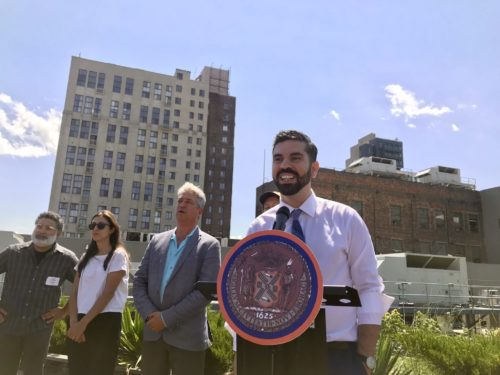
Some plans try to include all gardens under one umbrella but, for many gardeners, that’s not the solution they envision for their eclectic and unique self-made spaces, especially since all the work is done by volunteers. Attempting to formalize unpaid work can cause undue expectations or burdens on volunteers, but some comprehensive policy plans include gardens and their volunteers, so striking a balance can be tricky.
"Denio - Amor Pirata (Bossa Nova remix)" by PowerpuffTune fades in
The New York City Council recently published a report called “Growing Food Equity in New York City.” It evaluates the city’s current rate of food insecurity, and makes recommendations for increasing access to fresh and nutritious foods. According to the report, about 1 in 8 New Yorkers struggles to eat healthy food every day. To change this, the Council suggests supporting community gardens by doing multiple things. One is to have the Department of City Planning change their tax lot classification from “vacant land” to something else so that they are not mistaken for empty land in public and private development plans. Another somewhat radical proposal is to have the Parks Department and Department of City Planning make community gardens permanent. The report also recommends that the Parks Department collect more data to truly measure community garden value, and that it create more channels for the sale of produce and the creation of education programs. As a final kicker, the report even recommends that gardeners should be able to earn income for their volunteer work. It’s clear that legislators are trying to rectify some of the long-standing issues community gardens have faced, but some feel their proposals seek to formalize and regulate them all in a way that is against the spontaneous and local culture of community gardens. Here’s Irene again on how gardeners feel about potential government overreach.
Irene Van Slyke: There’s always been this thinking somewhere that “All these community gardens—why are they so separated? You know, we should have one... overarching organization that takes care of them all and decides the rules.” And you know, we have always fought against it and the Coalition has felt that no, that’s not where they want to go either. You know, but that thinking is still out there.
So citywide policies may not be the solutions gardeners seek, but they do represent new opportunities for formalization and permanence. Even Councilmember Espinal’s achievement of an urban agriculture website and online database of available sites for community gardens is something advocates and gardeners have long yearned for. In its absence, an organization called 596 Acres sprang up. Co-founded by Paula Segal, the attorney cited in previous episodes as a champion for community gardens in land disputes, the organization launched an online platform that mapped all the publicly owned vacant lots in the city. For each available lot, the site provided a forum where folks could post comments and photos to start a community garden.
"commonGround" by airtone fades in
It was very successful and helped create many community gardens, but stopped having a paid staff last year. Today, the platform is still live and usable, but no staff members can help community folks in any of their endeavors. The name '596 Acres' came from the start of the project in 2011, when the co-founders analyzed a municipal dataset and discovered that Brooklyn had 596 acres of publicly owned vacant land. Realizing the vast potential for new public access to open space, they launched the organization. The new City database is perhaps not as useful, available as a spreadsheet that can be downloaded without a map or an online platform with resources and local users, but it does represent the City’s larger steps towards supporting garden permanence and creation.
"commonGround" by airtone fades in louder
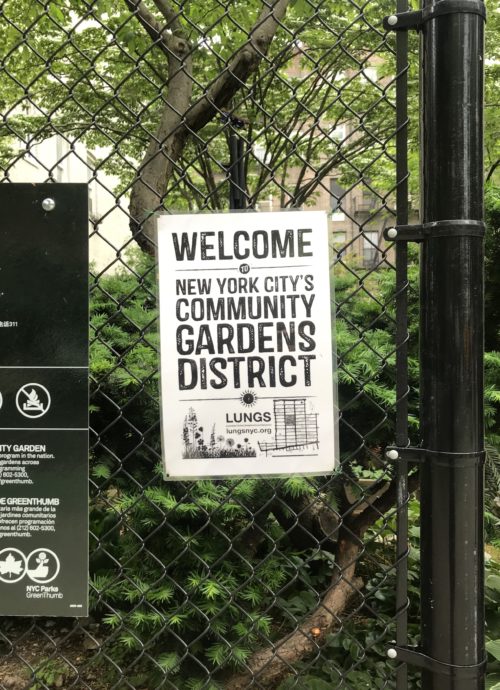
Some garden groups have taken preservation into their own hands. LUNGS, the Loisaida United Neighborhoods Gardens of the Lower East Side in Manhattan, established their own Community Garden District. Similar in theory to a historic district created and approved by the Landmarks Preservation Commission, it’s an informal cultural district that covers the Lower East Side, from the East Village and Alphabet City to parts of SoHo. The idea was to create a unified brand and the execution was simple: LUNGS printed and laminated their own signs and hung them on the fences of all the community gardens in the area that wanted to participate. Here’s LUNGS President, Charles Krezell, who you may remember from our last episode, explaining the context.
Charles Krezell: Our battle is with development here. You know, the gardens are all ripe for the picking now. Before they weren’t valuable at all, now they’re very, very valuable; the land is very valuable. So the garden district was sort of—sort of that saying, if we actually could create a garden district, they wouldn’t dare come in and try to break that up. I think just saying “we are something” is coming out of the closet—or coming out of the garden shed, saying, you know, “We are now this district. Don’t even mess with us because we’re all united and we work together, and if you attack one of us, we’ll all go crazy.”
This straightforward guerilla tactic is very much in line with the do-it-yourself community gardening spirit. It’s resulted in greater visibility and awareness for the neighborhood’s community gardens. However, the designation of the district is still strictly informal, which means the community gardens are still as unprotected as they were before.
Charles Krezell: We had hoped that we could get the City Council to pass a resolution acknowledging that but there are different people that have different ideas about how that should be approached. Personally, I think it should just be something that we declare, but they want much more of a legal situation and I think that’s kind of overreaching a bit.
Once again, gardeners yearn for simple solutions to issues public officials take more measured approaches on. For the gardens in the Community Garden District, it might not be their cultural significance that propels them into permanent preservation, but their environmental value.
"Temperate transition" by Bluemillenium fades in
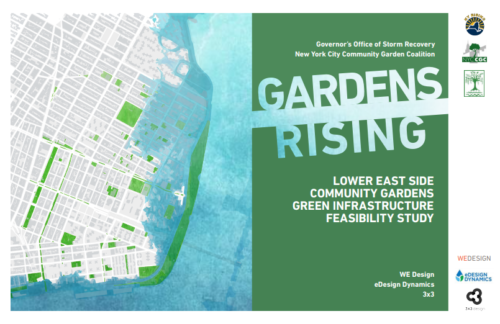
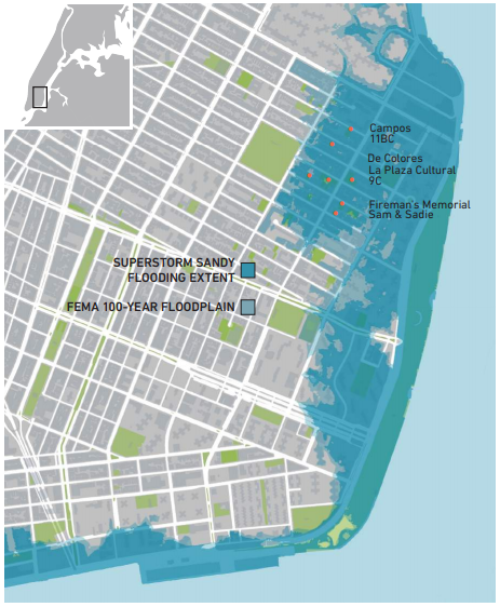
When Hurricane Sandy crashed into New York City in October 2012, whole swaths of Lower Manhattan were flooded and left without utilities for weeks. Community gardens became central gathering spaces for locals left without power. Many of the gardens suffered some damage—broken structures or fallen trees—but most fared the storm well. Because of gardens’ ability to absorb water and reduce flooding, the New York City Community Garden Coalition was allotted $2 million to develop and implement a green infrastructure plan that would upgrade the nearly 50 gardens in the area to be better prepared to absorb rainwater and withstand extreme conditions. The funds came from the New York Governor’s Office of Storm Recovery through the New York Rising Community Reconstruction Program. The feasibility study, called “Gardens Rising,” was released in 2016 and calls for many changes, including 43 new rain harvesting systems, over 30 pollinator and sustainable gardens, and over 20 new signs to explain the green infrastructure techniques to the public, among other upgrades and changes. These recommendations were formed after many site visits and community meetings, and represent an exciting opportunity for new investments into garden spaces and more formal recognition of their value. However, the implementation of the recommended strategies may take longer than gardeners initially thought.
Charles Krezell: I mean, we’re working with City property and money from the Federal government that’s run through the State. So we’re working with these three different entities, which is just totally—you know, we have to get everything approved on three different levels. And we’re hoping to start drilling to see whether we can put bioswales in the neighborhood. We have yet been able to do that. So we’ve been held off for an extended period of time, and we’re hoping that this summer we’re going to be able to start doing some work. But the feasibility study is still sitting there—a beautiful piece of paper that has not yet been fully realized so... it’s frustrating. It’s been very, very frustrating.
While gardens are being recognized and granted funds for their environmental qualities, green infrastructures may not lead to garden permanence and stability. Environmental recognition at the State level, however, could turn things around. An effort by researchers is underway right now to get community gardens in New York City classified as Critical Environmental Areas by the New York State Department of Environmental Conservation. These areas are designated based on their natural qualities, unique character or value, potential benefit or harm to human health, and potential to be affected by changing surrounding factors. Once an area is designated as a Critical Environmental Area, it is subject to increased protections under state environmental law, requiring more thorough analysis as part of the State Environmental Quality Review process. For gardens in New York City, this designation would not limit development on them, but it would require that any action on garden land or next to it go through a State-level environmental review and approval process. So far, this effort is still yet to see results.
"Temperate transition" by Bluemillenium fades in louder
There are many moving pieces meant to achieve the City and State’s various sustainability goals. In 2017, the City launched the “Cool Neighborhoods” initiative, which aims to combat extreme heat. While it made no mention of community gardens, it did include green roofs, which are building roofs with planted areas that absorb rainwater and reduce noise and air pollution. Then in April of this year, new legislation was passed that mandates all new residential and commercial buildings in the city to be covered in either green roofs or solar energy systems, representing another big step towards increasing sustainability and addressing climate change. Some green roofs have been initiated as community gardens to increasing but limited success, and government agencies are recognizing both green roofs and community gardens as valuable spaces, which is indicative of possible future public investments and policies. Gardeners and community residents I spoke to agreed that community gardens should be invested in, especially before it’s too late. Here’s a handful of them, starting with Aziz Dehkan.
“La Casita de Chema” by Tato Torres fades in
Aziz Dehkan: You know, I think we diminish open space because it looks empty. You know, we cherish glass buildings these days that are, you know, 50 feet high, you know, 50 stories high, and that’s where we’re headed, and look at Hudson Yards, I mean, there’s no open space at all in Hudson Yards, and what is that about? So the whole purpose is to give meaning and definition to “What is open space?” and it's not just—you know, it’s two words, but it’s a huge encompassing of what it means, so that’s what we’re trying to find out. What does it mean and how do you push it to legislators who can give these community gardens, these open spaces some permanence.
“La Casita de Chema” by Tato Torres fades in louder
Here’s Gloria Tellez-Tovar, Bushwick resident.
Gloria Tellez-Tovar: No we want to be that district that is growing and blooming, allow us to grow and bloom! Tell the City not to—don’t inhibit us from growing. Please encourage us to grow. You know, allow us to bloom. I wouldn’t want the City to discourage us in any way. I mean, the City will always have its own ways, but at the same time, the City is always saying a lot of things so do hold the City accountable! You know, so get them involved, let them know. I would like to see a time where getting the number of asthma and diabetes and hypertension to lower in our district. In the Needs Assessment that comes out that the Community Board does for the whole community, I mean, health is a major issue, you know, and to have it—those numbers reduced and people are living better, people are eating healthier... we shouldn’t shy away from that. I think that’s even more beneficial for us. Eating differently will have a huge significant impact and keeping these gardens, keeping them part of the rezoning, preserving them through the rezoning, bringing this up to whatever group or elected officials or any form of proposal is—I encourage that, yeah. Yes. We should.
“La Casita de Chema” by Tato Torres fades in louder
Amantina Duran, Williamsburg resident and gardener.
Amantina Duran: Creo que eso es necesario que la ciudad invierta dinero para el desarrollo de los jardines. Y también si puede haber, como decir, ustedes están haciendo el estudio pero de ese estudio, de aquí se pueda sacar una manera de cómo hacerlo en una manera por barrio, por sectores, porque como que hay muchos pero no hay mucha estructura.
Translation: I think the city should invest money into the development of gardens. If there could be a study, like what you’re doing, and from there, figure out how to develop them by neighborhood, by sectors—because there are many gardens but there’s not much structure.
“La Casita de Chema” by Tato Torres fades in louder
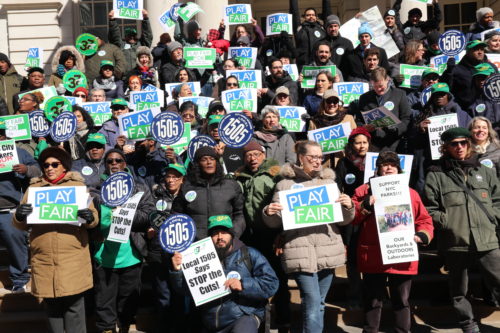
The demand is clear: gardens are valued and should be invested in. Last year, New York State Governor Andrew Cuomo pledged $3.1 million to support 22 community gardens in Brooklyn as part of his “Vital Brooklyn” initiative, which aims to reduce negative health outcomes and increase access to affordable housing and quality open space in that borough. While this represents a significant investment, the City has many competing needs. The City itself dedicates .59% of its total budget to the NYC Parks Department, of which a fraction goes to the GreenThumb community gardening program. Since the Parks Department cares for 14% of New York City’s land, this less-than-one-percent budget allocation seems insufficient, and the City’s parks and open spaces have suffered due to longstanding lapses in maintenance. But earlier this year, those tides shifted a bit, both for the City’s parks and community gardens. The Play Fair campaign, led by our organization, New Yorkers for Parks, and other great partners, succeeded in increasing the Parks Department budget by $44 million, which were invested into maintenance and operations. Of those $44 million, $8.2 million were specifically earmarked to support all 550 community gardens citywide. These funds are still in the process of being distributed but have the potential to improve and upgrade many gardens once completely allocated. The new funds demonstrate the City’s commitment to acknowledge and enhance the network of community gardens, but still don’t ensure permanence for these volunteer-run spaces.
"Ana's Guitar, Open Window" by gurdonark fades in
After all this information, maybe you’re looking to join this citywide volunteer effort. So let me tell you how you can get involved in New York City’s community gardens! You can visit one, talk to anyone you see within to learn more about that particular one, and you can offer to volunteer. Some gardens are always looking for volunteers to help with the work, so if you’re able and willing, try to ask around and see where you can be helpful. If you’d like to be involved and can’t or don’t want to participate in garden work, you can still visit, spread the word about it, and be helpful in other ways. For example, if you’re tech savvy, you can maybe help a garden group secure more supplies through the City’s various programs, or you can help a volunteer garden group design flyers, spread the word, or even apply for a grant. There are lots of great programs from a bunch of organizations like GreenThumb, GrowNYC, the Citizen’s Committee for NYC, and many others, that can be useful to garden volunteers. Helping connect them to those resources is greatly appreciated. If you’d like to contribute monetarily, you can donate to nonprofits that support gardens or to the various land trust organizations directly. You can also try to be more engaged in your community. Pay attention to local news and go to community meetings to hear about what’s going on. The more involved you feel, the more likely you’ll participate in a volunteer effort like a community garden, and the more you’ll learn about your neighborhood and neighbors. There are opportunities that can blossom through partnerships waiting to form. Here’s Kofi Thomas, a recurring voice here on Lots to Grow, gardener in Bushwick, and tech-savvy volunteer for the Brooklyn-Queens Land Trust.
"Ana's Guitar, Open Window" by gurdonark fades in louder
Kofi Thomas: People should view gardens differently. And it’s partially on both sides, people who are in gardens and people who walk by gardens, but when I talk about expectations and being able to—being able to see the potential or use of a space... you know, I think people should really rethink and reimagine what they can do inside of gardens, especially if you live in a town with not a lot of green space. Like if you want to have a birthday party for your kid, if you have a book club that wants to meet, if you want to meet up with some friends and you know, paint or photography, or if you’re a community group that wants to get together and talk about policy. Like this is a space where so many people could meet and connect, and, you know, help the community grow. Also on the part of old neighbors who walk by gardens and think to themselves, “Oh, well I don’t know if I could go in there,” but also you live here, so also what’s it going to hurt you to one day say hello and be a neighbor? And even if you don’t garden, just to say like these are the people beautifying a little part of your neighborhood, just to say like—just to be a neighbor and wave and say hello. I think that would go a long way. There’s still a little bit of disconnect between people feeling welcome in garden spaces, and so yeah, I hope that changes.
"Ana's Guitar, Open Window" by gurdonark fades in louder
Today, GreenThumb, the Parks Department, and some community gardeners are still at odds with each other in the ongoing negotiations over the garden license agreements.
Carlina Rivera: ...People come from all over the world because they are inspired. They are inspired by what we have done when the City abandoned and neglected us. So the City has not done us a favor...
That was the voice of Councilmember Carlina Rivera at the same September rally from the beginning of the episode. It’s impossible to know how this back-and-forth will play out in the end, but it’s clear from our research that there are no simple solutions for the various issues concerning New York City's community gardens. Gardeners and community members often agree that community gardens should be protected in some way, but advocates for other urban infrastructure sometimes favor the City’s current ability to take a garden group’s temporary permission away. From private nonprofits to emerging land trust models to citywide programs that address social and environmental effects, the current array of solutions seem expansive but inadequate. It seems that each garden is best dealt with on a case-by-case basis, but current public agencies most likely do not have the capacity to pursue this process. From their management to their permanence, different solutions will be needed for different places. People care deeply about these spaces, so deeply that they’re willing to volunteer hours of their time, month after month, year after year, and willing to advocate for them time and time again to elected leaders. Few things inspire such passion in people, so no matter what happens in the future, this decades-long era of community gardening in New York City will always symbolize the glowing resilience and creativity of New Yorkers.
“The Garden State” by Audiobinger fades in
However you choose to be involved, we hope that by listening to this podcast, you feel more informed about community gardens in New York City. Lots to Grow has been our effort to explore the complexities that make and surround these unique open spaces. Volunteer gardeners come from all different walks of life and are motivated to participate for all different reasons. We admire the stewardship of New York City land, and appreciate volunteers’ beautiful acts of selflessness to the community, city, and Earth.
“The Garden State” by Audiobinger fades in louder
Thank you for listening to our last episode of Lots to Grow, the podcast about gardens and communities by New Yorkers for Parks. I’ve been your host, Jessica Saab. It’s been a pleasure to present this research project to you. As always, for our show notes, sources, photos, and additional information about this project, like how it was made and with what equipment, check out our website at ny4p.org/lotstogrow. That’s “N,” “Y,” the number four, “P.” The Leon Levy Foundation, as well as WeWork, made this project possible. I’d like to thank all those who spoke with me and answered my questions, both on and off the record. On this episode we heard from: Aziz Dehkan, Irene Van Slyke, Genevieve Outlaw, Celeste Leon, Mychal Johnson, Charles Krezell, Gloria Tellez-Tovar, Amantina Duran, and Kofi Thomas. The music on this episode is by Audiobinger, Speck, Stefan Kartenberg, Martijn de Boer (NiGiD), onlymeith, norelpref, yurex, ritmosrudos, PowerpuffTune, airtone, Bluemillenium, Tato Torres, and gurdonark. Last, thank you, our listener, for tuning in. I appreciate you listening, I hope you got to hear the other episodes, and I encourage you to share Lots to Grow with others. To help us out, rate this show on Apple Podcasts and leave us a review. To stay in touch, join the New Yorkers for Parks email newsletter list or follow us on social media – we’re on Twitter, Instagram, Facebook, LinkedIn, and even YouTube! Thanks!
“The Garden State” by Audiobinger fades out – end of recording
- Land Trust Alliance. "About Us." https://www.landtrustalliance.org/about-us
- NYC Department of Finance. "Lien Sales." https://www1.nyc.gov/site/finance/taxes/property-lien-sales.page
- Community-Wealth.org. "Community Land Trusts (CLTs)." https://community-wealth.org/strategies/panel/clts/index.html
- Emma Whitford. "NYC Just Made Its Biggest Commitment Ever To A Radical Affordable Housing Model." Gothamist, August 4, 2017. https://gothamist.com/news/nyc-just-made-its-biggest-commitment-ever-to-a-radical-affordable-housing-model
- Jen Carlson. "Will the South Bronx Casitas Get Landmarked?" Gothamist, February 23, 2009. https://gothamist.com/news/will-the-south-bronx-casitas-get-landmarked
- Molly Garfinkel. "Preserving a Hometown Corner for Posterity: Casita Rincón Criollo as a Traditional Cultural Property." CultureWork 18, no. 1. January 29, 2014. https://culturework.uoregon.edu/2014/01/29/january-2014-vol-18-no-1-preserving-a-hometown-corner-for-posterity-casita-rincon-criollo-as-a-traditional-cultural-property-molly-garfinkel/
- New York City Council. "Int. 1661-2017 Requiring the dept of city planning, dept of small business services, and the dept of parks and recreation to develop urban agriculture website." New York City Council, enacted January 11, 2018. https://legistar.council.nyc.gov/LegislationDetail.aspx?ID=3106769&GUID=C1DA662E-E6E5-471D-91FF-170F1B12332A&FullText=1
- Department of Parks and Recreation. "City-owned sites that are available and potentially suitable for urban agriculture (Local Law 46 of 2018)." City of New York, last updated October 2018. https://data.cityofnewyork.us/Environment/City-owned-sites-that-are-available-and-potentiall/qchy-end3
- Council Speaker Corey Johnson. "GROWING FOOD EQUITY IN NEW YORK CITY: A City Council Agenda." New York City Council, August 2019. http://council.nyc.gov/data/wp-content/uploads/sites/73/2019/08/growing-food-equity-1.pdf
- 596 Acres. "Mission and Story." http://596acres.org/mission-and-story/
- Patrick McGeehan. "6 Years After Hurricane Sandy, Here’s What They Came Up With: Really Big Sandbags." The New York Times, May 5, 2019. https://www.nytimes.com/2019/05/05/nyregion/hurricane-sandy-manhattan-flooding.html
- WE Design, eDesign Dynamics, 3x3. "Gardens Rising: Lower East Side Community Gardens Green Infrastructure Feasibility Study" Governor’s Office of Storm Recovery, New York City Community Garden Coalition, 2016. http://gardensrising.org/wp-content/uploads/2016/12/161205_Report100F.pdf
- New York State Department of Environmental Conservation. "Critical Environmental Areas." https://www.dec.ny.gov/permits/6184.html
- New York City Mayor’s Office of Recovery and Resiliency. "Cool Neighborhoods NYC." New York City Mayor’s Office of Recovery and Resiliency, June 14, 2017. https://www1.nyc.gov/assets/orr/pdf/Cool_Neighborhoods_NYC_Report_FINAL.pdf
- New York City Council. "Int. 1032-2018 Requiring that the roofs of certain buildings be covered in green roofs or solar photovoltaic electricity generating systems." New York City Council, enacted 5/19/2019 https://legistar.council.nyc.gov/LegislationDetail.aspx?ID=3557657&GUID=B4C3A822-2FBB-45FD-8A74-C59DD95246C1&Options=&Search=
- The Official Website of New York State. "Funding for the Vital Brooklyn Initiative: Open Space and Recreation." https://www.ny.gov/transforming-central-brooklyn/funding-vital-brooklyn-initiative#open-space-and-recreation
- New Yorkers for Parks. "Play Fair." http://www.ny4p.org/what-we-do/play-fair
- NYC Department of Parks and Recreation
- NYC Parks GreenThumb
- New York City Community Garden Coalition (NYCCGC)
- Land Trust Alliance
- The Manhattan Land Trust
- The Bronx Land Trust
- The Brooklyn-Queens Land Trust (BQLT)
- The Trust for Public Land
- The New York Restoration Project
- Brooklyn Community Board 4
- South Bronx Unite
- Mott Haven-Port Morris Community Land Stewards
- NYC Landmarks Preservation Commission
- NYC Council
- NYC Department of City Planning
- 596 Acres
- Loisaida United Neighborhood Gardens (LUNGS)
- NYS Governor’s Office of Storm Recovery
- NYS Department of Environmental Conservation
- GrowNYC
- The Citizens Committee for NYC
- Leon Levy Foundation
- WeWork
Thank you for listening!
Be sure to leave a review on Apple Podcasts.